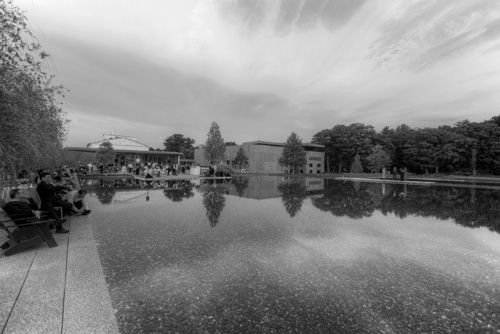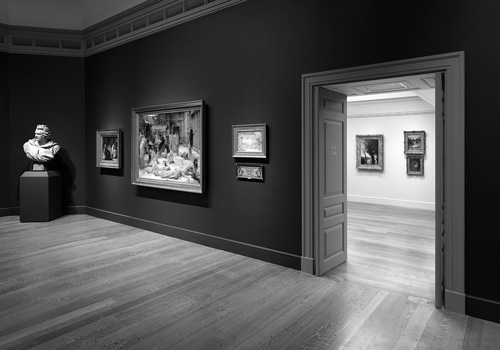Arts & Culture
A museum transformed
Clark opens anew with expanded facilities, revamped layout
By TELLY HALKIAS
Contributing writer
WILLIAMSTOWN, Mass.

The Clark Center, a new visitors center, and the Manton Research Center are seen from across a new 1-acre reflecting pool at the redesigned campus of the Sterling and Francine Clark Art Institute in Williamstown.
For lovers of fine art, it’s an occasion worthy of fireworks: On the Fourth of July, the Sterling and Francine Clark Art Institute will reopen with new and expanded facilities on its 140-acre campus, completing a redesign that’s been discussed and planned for at least a decade.
Michael Conforti, the museum’s director, said the project involved four architectural firms and reconceptualizes visitors’ experience of the Clark. As a result, it represents the most significant transformation since the museum’s first building opened to the public in 1955.
“This project advances the Clark’s dual mission as both an art museum and a center for research and higher education,” Conforti said.
The project cost more than $100 million and is the realization of a master plan developed more than 10 years ago. Through that plan, Conforti explained, the art institute set out to better connect its program and support services with the landscape of its campus – with a goal of improving the experience for the thousands of people who come from all over the world to visit the Clark each year.

The new visitor center was designed by Pritzker Prize winner Tadao Ando Architect & Associates of Osaka, Japan, while the expanded museum building and the renovated Manton Research Center both were designed by Selldorf Architects of New York.
These buildings surround a new 1-acre reflecting pool, the highlight of a dramatic rethinking of the Clark’s landscape designed by Reed Hilderbrand of Cambridge, Mass. Gensler of New York served as the executive architect for all phases of the venture.
The project has added more than 13,000 square feet of gallery space, supporting the Clark’s enhanced collection and exhibition programs. Conforti said it also establishes the institute as a leader in best practices for environmental sustainability and energy efficiency.
“What now looks simple, and so logical, has been achieved through a complex and environmentally sensitive design and construction program that unites many disparate parts,” he said.
Supporting a wider range of art
As complex and intricate as the planning has been, the Clark’s reinvention is far from just a series of construction projects. From the perspective of the curatorial department, the physical transformation of the campus, starting with the opening of the new Stone Hill Center exhibition galleries in 2008, always returns to how the public connects with art.
Richard Rand, the Clark’s curator of paintings and sculpture, said the new special exhibition galleries greatly enhance the museum’s ability to create a broader array of exhibitions.
“The old galleries in the Manton Research Center did not lend themselves to exhibiting large works of art or contemporary art,” Rand said. “The galleries at Stone Hill Center and the new visitor center have much higher ceilings, improved lighting, and much more flexibility in reconfiguring the size and shapes of the galleries.”
Some exhibitions, Rand added, would not have looked as luminous in the Manton galleries as they might in Stone Hill Center, because the scale of the works would have been lost. Certain art, he explained, is better suited for a specific space.
“It’s worth noting that the new galleries aren’t specifically designed for contemporary art,” Rand said. “We have shown our permanent collection in Stone Hill Center, and we will be showing ancient ritual bronzes from China in the new visitor center this summer.
“The new galleries really open the door for the curatorial department to display works of art and exhibitions that we simply couldn’t have done” in the past, he added.
The new construction, however, kept its artistic focus on the Clark’s permanent collection, known globally for the depth of its offerings – especially considering the size of the Clark relative to larger museums.
Rand said no one ever intended to radically change the visitors’ experience in the museum building.
“It has always been about subtle but dramatic improvements,” Rand said. “The flow through the galleries is improved. We have reclaimed some ‘back of house’ spaces and have increased the amount of space in the galleries. The old-loading-dock gallery is now a beautiful space dedicated to American art, and the original museum entrance lobby has been transformed into a sculpture conservatory.”
Rand added that the enhanced architectural details are more visually appealing, paint colors are all new, and the lighting has been greatly improved.
“For those who will visit the Clark for the first time, we hope they will find these galleries to be the ideal setting in which to discover one of the greatest private collections in North America,” he said.
The reinstallation of the permanent collection also marks the return of 73 works from the Clark’s collection of 19th century French paintings after a world tour. Over the past three years, some 2.6 million people have seen those paintings at 11 venues, from the Museo del Prado in Madrid to the Shanghai Museum.
Three special exhibitions
In conjunction with the Clark’s reopening and the reintegration of its permanent collection, this summer the institute will present three special exhibitions. The shows include “Cast for Eternity: Ancient Ritual Bronzes from the Shanghai Museum,” and “Raw Color: The Circles of David Smith,” which both will debut as part of the grand inaugural on the Fourth of July weekend.
The third special exhibition -- “Make It New: Abstract Painting from the National Gallery of Art, 1950-1975” -- will open Aug. 2.
On view in the West Pavilion gallery of the new visitor center, “Cast for Eternity” presents some of the finest surviving examples of early bronze work from the Shanghai Museum’s collection. The rare bronzes, dating from the late Xia Dynasty through the Western Han dynasties (from about 1800 B.C. to A.D. 8), represent the finest quality craftsmanship and artistic accomplishment from China’s Bronze Age.
Kathleen Morris, the Clark’s director of collections and exhibitions and its curator of decorative arts, said this show continues the Clark’s partnership with China’s Ministry of Culture and a number of Chinese cultural institutions.
The exhibition “evolved from our cultural exchange with the Shanghai Museum,” Morris said. “In 2013, our masterpieces were on view there, where they were seen by over 500,000 people. In exchange for that exhibition, the Shanghai Museum agreed to provide the Clark with two smaller exhibitions in the future. The first of these projects will bring 35 magnificent examples of ancient ritual bronzes to the Clark this summer.”
The second show, “Raw Color,” is installed in the intimately scaled galleries and surrounding outdoor spaces of the Clark’s Stone Hill Center. It’s a selection of works by one of the 20th century’s most celebrated sculptors.
It will mark the first time in three decades that all five of the key sculptures from David Smith’s “Circle” series (1962-63) are shown together. Morris said the Clark’s new campus offers a setting that is similar to that of Smith’s home in Bolton Landing, N.Y., where the artist created and originally installed the Circle series. She said this provides an appropriate artistic twist for the Clark and opens new avenues for its future.
“An exhibition of that period would carry an appropriate irony,” Morris said. “The contemporary art of those years was just what Sterling and Francine Clark -- who died in 1956 and 1960 -- and later, the Institute, did not collect. The opening of a new building in 2014 would be a chance to look back at a missing piece of history while laying the groundwork for the Clark’s greater engagement with modern art.”
Landscape sustainability
The final component of the new campus is the carefully integrated landscaping, something Clark officials emphasize as a vital to the whole.
Reed Hilderbrand, led by principal Gary Hilderbrand, worked in close collaboration with Ando to articulate a landscape design for the Clark that achieves new levels of environmental sustainability and further enhances the visitor experience. Its unifying element is the tiered reflecting pool, which creates the focal point of the new main campus and bonds the three surrounding buildings with the natural setting.
The reflecting pool is at the heart of an integrated hydrology program that considerably reduces the Clark’s natural resource consumption and complements its land management program. Other key elements of the design include substantial new plantings of native species, including some 1,000 trees, and the removal of invasive plants. There are upgrades to the existing network of walking paths and trails, a new entrance drive, and landscaped parking areas that accommodate 340 vehicles.
“Our design for the final phase of the campus brings the landscape into exemplary alignment with the Clark’s commitment to stewardship,” Hilderbrand said. “The beauty of the reflecting pool and surrounding lands are certainly important, but we’re extremely satisfied with the knowledge that we have evolved, over the last 10 years, a complex landscape that reflects its cultural roots in the northern Berkshires.”
Conforti said he takes heart in the effort put forth by all involved in the Clark project, and he predicted its influence will be felt past regional boundaries.
“The summer of 2014 will be a special time in the Berkshires, a region noted internationally for its extraordinary cultural venues,” Conforti said. “The Clark will be a place of discovery, inside and out, that visitors will want to explore. Between the many other museums in the region and the wonderful performances at Tanglewood and the Berkshires’ many theater and dance companies, we hope to engage the world in discovering one of the nation’s most exceptional artistic and cultural communities.”
The Clark Art Institute, at 225 South St. in Williamstown, is open from 10 a.m. to 5 p.m. daily through Oct. 13, and until 7 p.m. on Friday evenings in July and August. For more information, visit clarkart.edu or call (413) 458-2303.

